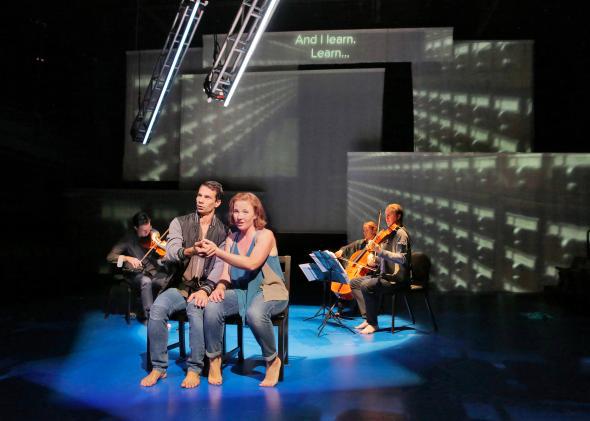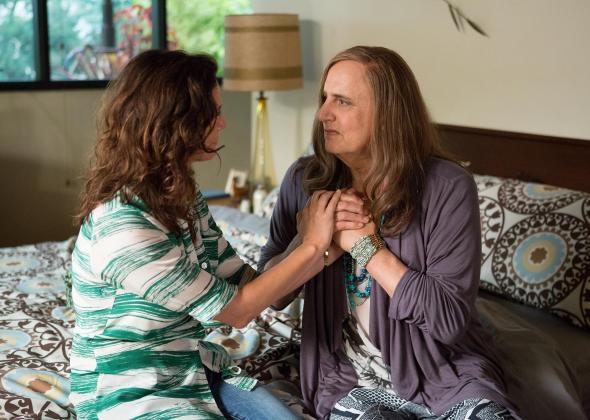“Trans visibility on TV is at an all-time high.” At the end of 2014, the truth of this sentence, clipped from coverage of ABC Family’s announcement that it will present a trans-focused reality series next year, is unassailable.
In years past, the existence of a critical hit like Amazon’s gorgeous, funny, and deeply humane Transparent would have felt like a massive step forward—but now we find ourselves in the fantastic (in both senses of the word) position of hardly needing to cling to a single sign of progress. For one thing, the queer brilliance of Orange Is the New Black continued, despite Laverne Cox’s character having a relatively minor part of the second season’s storyline. (You could, of course, easily find her at America’s newsstands on the cover of Time.) MTV took a break from catfishing in October to broadcast The T Word, a powerful documentary hosted by Cox, and this fall AOL brought musician Laura Jane Grace’s great profile series True Trans to the world. This short list can’t begin to account for all the smaller inclusions of trans characters, actors, or themes in other programs, like The Fosters’ Cole, American Horror Story: Freak Show’s Amazon Eve, or South Park’s excellent episode on gender-neutral bathrooms. And the television influx isn’t over; as the Advocate recently noted, we could see as many as seven trans-oriented shows on the air at once in 2015.
Away from the glow of the screen, the trans experience has become an important subject in the other arts as well. Laura Jane Grace’s punk band Against Me! released the album Transgender Dysphoria Blues in January, kicking off a spate of gender exploration in music, and trans visual artists Zackary Drucker and Rhys Ernst (also associate producers on Transparent) had their autobiographical work featured in the prestigious Whitney Biennial. In September, the Brooklyn Academy of Music and American Opera Projects presented the world premiere of As One, an elegantly realized chamber opera that was entirely devoted to one trans woman’s coming-out process.
Add all these fictional and documentary portrayals to the sudden emergence of public trans icons like Cox, Janet Mock, and Carmen Carrera in mainstream discourse, and it can be hard to remember a time when “trans visibility” was a commodity in short supply. Of course, that time was not long ago at all, and daily life for the majority of trans people—especially trans women of color—remains precarious: We shouldn’t underestimate the work still necessary to secure civil protections and combat widespread transphobia. That said, I do think it’s worth taking a step back at a moment when “trans” is such a large part of the cultural conversation to consider how this happened and what it might mean. Why has this particular minority experience proved so rich with creative possibility? Why do artists working in a range of mediums find it so appealing? Why “trans art,” and why now?
A good portion of the trans ascendance stems, understandably, from an activist impulse. Some creators explicitly want to educate or to increase visibility for its own sake, as in the documentary projects. Others, especially those like Grace who are trans themselves, want to offer personal testimony. Transparent’s creator Jill Soloway elegantly articulated her motivation as being both personal and political: “I wanted to make something that would make the world safer for my parent.” Like the show’s central character Maura, Soloway’s father came out as a trans woman later in life.
But the desire to introduce more audiences to trans people and their experiences, a drive based in social justice more than aesthetics, cannot solely explain the sudden boom. (Nor, for that matter, could the cynical notion of a producer wanting to jump on the “provocative subject” bandwagon.) After all, there are plenty of minority communities who are underrepresented in popular media and the art world, and transgender people make up a relatively tiny population group compared with most of them. That’s not to say that trans stories or concerns aren’t “important enough” to deal with artistically, of course; it’s just that there would seem to be other reasons that artists and culture-makers, many of them cisgender and/or not queer, find “trans”—as an idea as much as an identity—to offer such fertile artistic soil.
So what are the uses of “trans” in art? Naturally, each of the examples mentioned above employs the theme in a slightly different way, but two of them feel particularly illustrative.

Ken Howard for American Opera Projects.
The chamber opera As One, composed by Laura Kaminsky with a libretto by Mark Campbell and trans filmmaker Kimberly Reed, makes use of the genre’s tendency toward sung self-revelation to sketch out a somewhat broad psychological profile of the transgender experience. The piece comprises three parts that follow a fairly predictable coming-out-story trajectory: stirrings and initial self-awareness; exploration, societal challenges, and community affiliation; and finally, self-acceptance and pride.
This narrative, in and of itself, is not particularly fresh; As One’s intelligence lies in the decision to cast two performers as Hannah, the trans woman protagonist: male baritone Kelly Markgraf as “Hannah before” and female mezzo-soprano Sasha Cooke as “Hannah after.” Importantly, the libretto does not split the run time in half as the names might suggest, but rather has the performers elegantly weave in and out of prominence, arias bleeding into duets and back again. This, to be clear, is not some clichéd “battle” between the sexes inside one person, nor is it an uncomplicated progression from man to woman. Instead, As One humbly acknowledges that gender is both central and mercurial, a thing of delicate, intricate, and somewhat arbitrary construction that nevertheless exudes a massive sort of gravity. We should all be empowered to settle on the shorthand (man, woman, butch queen, genderqueer, etc.) that feels most true—such freedom is vital. But an honest conceptual model requires that everyone, even the most self-assured among us, begin to understand gender as more a chorus of unruly voices than a pure-toned solo.
Transparent, though completely distinct from As One in terms of genre conventions and tone, similarly celebrates the messy noise of transition. The series, which maps the surprising and often funny ways Maura’s coming out as a trans woman ripple through her neurotic West Coast family, is compelling not (or not only) because of its “timely” subject matter or Jeffrey Tambor’s sensitive performance. Soloway’s real achievement lies in how she contrives for a literal transgender catalyst to launch all of her characters on the unique journeys of transition that they each need to undertake. The show insists that everyone be in motion. Of course, motion is always more uncomfortable than stasis, but Transparent’s argument seems to be that there’s something useful, even crucial, about acknowledging and grappling with the discomfort of change and realignments. If the show has one moral, it has to be this: Always be suspicious of easy stability.
These expanded uses of “trans” are what keep As One and Transparent from being simplistic, checkbox-motivated pieces of identity art. For the function of “trans” in each is about more than providing a vicarious (and perhaps “enlightening”) experience of some curious Other. Far better, “trans” becomes a way of thinking through how all human beings must do the uncomfortable work of bringing their inner tune into some kind of harmony with the larger conventional chord structures already in progress around them. Those of us who have less difficulty being understood by society—to be heard as we hear ourselves—could stand to learn a great deal from those who were not born with the privilege of taking that audibility for granted. For one thing, we might become more attuned to the smaller “transitions” and adjustments everyone must undertake to “make sense” in the world. But more important, we might also come to question whether some of the requirements for achieving that kind of intelligibility are entirely just.
On the question of justice, it’s worth quickly bringing in Judith Butler, a philosopher whose thinking on gender, the human, and social legibility is useful for understanding the kinds of artistic explorations that “trans” allows. Butler observes in her essay “Doing Justice to Someone: Sex Reassignment and Allegories of Transsexuality” that “[Justice] emerges in quite consequential decisions about what a person is, what social norms must be honored and expressed for personhood to become allocated, how we do or do not recognize animate others as persons depending on whether or not we recognize a certain norm manifested in and by the body of that other.”
Butler is challenging us to see justice not only in how fairly the law or society treats a person, but also as existing in the implicit tests we use to measure the relative “humanity” of other human beings. Gender—specifically, adherence to a certain set of norms around what male and female “look like”—is clearly one of the most basic of these metrics, and so any person or idea that disturbs those norms will tend to be met not just with hostility, but more profoundly, with a fundamental incomprehension. To be trans or intersex or otherwise beyond the traditional binary is to risk not being seen as fully human.
“Trans” as an artistic theme, then, has the benefit of casting light on social boundaries—the limits of humanness—that are usually invisible, at least to those privileged enough not to be constantly running up against them. One of art’s jobs is to explore and push beyond these sorts of boundaries, so it’s no surprise that so many artists have found “trans” to be a useful tool.
But why now? For one thing, trans activism has brought about enough visibility to make the theme intriguing to both creators and sympathetic audiences. A more compelling reason, though, is the fact that other modes of artistic inquiry are starting to feel exhausted. Take gay sexuality: For decades, the marginalized nature of homosexuality offered this kind of cartographical implement to artists interested in borders and boundaries. But the success of the gay rights movement has meant that many (though certainly not all) gays, lesbians, and bisexuals have moved away from the margins and into the mainstream, blunting gayness’s critical power along the way. Gayness increasingly feels stable, safe, and accepted; if I were an artist, I would struggle to find it worth exploring.
But then, “deviant” sexuality was never that challenging to the status quo—after all, everyone understands an orgasm. But gender? That’s some ingrained, root-of-the-mountain stuff, and testing it necessarily triggers larger cultural tremors. Clearly, many of our most creative artists are in the market for a quake. I cannot think of a better wish for 2015 than that it be positively seismic.
